Post by Stingray on Jul 11, 2008 19:24:48 GMT -4
Kamov Ka-26 "Hoodlum"
1965
--------------------------------------------------------------------------------
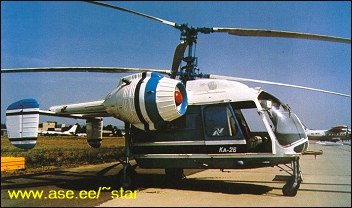
www.aviastar.org/helicopters_eng/ka-26.php
NATO reporting name: Hoodlum-A
TYPE: Light twin-engined multipurpose helicopter.
PROGRAMME: Prototype first flew 1965; production aircraft entered agricultural service in Soviet Union 1970; 850 built. It is widely used on air ambulance services and is suitable for many other applications, including cargo and passenger transport, forest firefighting, mineral prospecting, pipeline construction, laying transmission lines and a number of military duties, including search and rescue.
The space aft of the cabin, between the main landing gear units and under the rotor transmission, is able to accommodate a variety of interchangeable payloads. For agricultural work the chemical hopper (capacity 900kg) and dust spreader or spraybars are fitted in this position, on the aircraft's centre of gravity. This equipment is quickly removable and can be replaced by a cargo/passenger pod accommodating four or six persons, with provision for a seventh passenger beside the pilot. Alternatively, the Ka-26 can be operated with either an open platform for hauling freight or a hook for slinging bulky loads at the end of a cable or in a cargo net.
A version for geophysical survey has an electromagnetic pulse generator in the cabin and is encircled by a huge 'hoop' antenna. It carries a mounting on the port side of the fuselage for the receiver 'bird' which is towed at the end of a cable, beneath the helicopter, when in use. The receiver is lowered by an electric winch and the cable is cut by automatic shears if its traction should exceed the authorised limit.
As an air ambulance, the Ka-26 can carry two stretcher patients, two seated casualties and a medical attendant. A winch, with a capacity of up to 150kg, enables it to be used for search and rescue duties. Ka-26s used in this role in Russian coastal areas are each fitted with three large inflatable pontoons, to permit operation from water. Items of equipment carried inside the cabin can include lifejackets and MLAS-1 inflatable dinghies for individual rescues, LAC-5 dinghies each able to carry five persons, PSN-1 rafts and emergency radio beacons. During tests, the hoist has been used to tow boats in Sea State 5 conditions.
When operating as an agricultural sprayer, the Ka-26 originally discharged its chemical payload at 1.5-12 litres/s. The rate of discharge in a dusting role was 1.5-12kg/s. Up to 120 ha could be sprayed during each flying hour at the rate of 50kg/ha. As a duster, 140 ha could be treated at the same discharge rate. 50 ha could be top-dressed with chemical fertilisers each hour, at a rate of 100kg/ha. These work rates were improved substantially by the introduction of an atomiser for liquid chemicals in 1978, followed by a centrifugal spreader for granular chemicals and dust in 1979.
To protect the pilot against toxic chemicals in the agricultural role, the cabin is lightly pressurised by a blower and air filter system which ensures that the cabin air is always clean. The flying and navigation equipment is adequate for all-weather operation, by day and night. VHF and HF radio are fitted, together with a radio compass and radio altimeter.
Because of its small size and manoeuvrability, the Ka-26 can be operated from platforms on small ships such as whalers and icebreakers, and a Soviet fishing boat operating in the North Atlantic in early 1970 carried a Ka-26 for fish spotting duties. This aircraft was equipped with inflated pontoons to permit alighting on the water.
In mid-1969, a Ka-26 was tested in Siberia and northwest USSR as a forest protection version able to deliver six firemen and their equipment speedily to the site of a forest fire. In the spring of 1972, Ka-26s joined Mi-1, Mi-2 and Mi-4 helicopters in operations to clear ice from Soviet rivers, by landing demolition teams on thick ice floes and destroying thinner ice fields from the air.
CUSTOMERS: Delivered for civilian use in 15 countries; military operators include the Hungarian Air Force.
DESIGN FEATURES: Airframe comprises backbone structure carrying flight deck, coaxial contrarotating rotors, landing gear, engine pods and twin tailbooms; space aft of flight deck, between main landing gear units and under rotor transmission, can accommodate interchangeable modules for passenger/freight transport, air ambulance, aerial survey, forest firefighting, mineral prospecting, pipeline and power transmission line construction, search and rescue, and (of primary importance) agricultural equipment.
POWER PLANT: Two 242.5kW Vedeneyev M-14V-26 air-cooled radial piston engines, mounted in pods on short stub wings at top of fuselage.
ACCOMMODATION: Fully enclosed cabin, with door on each side, fitted out normally for operation by single pilot; second seat and dual controls optional. Cabin warmed and demisted by air from combustion heater, which also heats passenger compartment when fitted. Air filter on nose of agricultural version. For agricultural work, a chemical hopper (capacity 900kg) and dust spreader or spraybars are fitted in module space, on the aircraft's centre of gravity. This equipment is quickly removable and can be replaced by a cargo/passenger pod accommodating four or six persons, with provision for a seventh passenger beside the pilot; or two stretcher patients, two seated casualties and a medical attendant in ambulance role. Alternatively, the Ka-26 can be operated with either an open platform for hauling freight or a hook for slinging bulky loads at the end of a cable or in a cargo net.
--Jane's Helicopter Markets and Systems
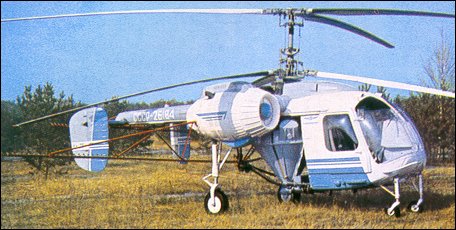
The year of 1956 saw the beginning of the wide-scale application of helicopters in the Soviet national economy. The need arose for helicopters capable of spreading fertilizers in the fields, orchards and vineyards and of combatting pests and weeds. To this end Ka-15M and Mi-1 helicopters were fitted with agricultural equipment. Operational experience gained with these types revealed the need for a dedicated helicopter with a bigger cargo-lifting capacity for performing a wide range of agricultural duties. This requirement was met by the Ka-26 featuring a modular design with interchangeable mission equipment (the "flying chassis").
In January 1964 the Soviet government issued a directive on the creation of the multi-purpose Ka-26 in two versions: the agricultural version capable of carrying 600-700kg of chemicals and the transport version for carrying passengers over distances of up to 400km. At the time our Civil Aviation already operated the agricultural version of the Mi-2 multi-purpose helicopter. The Kamov OKB was faced with the task to build a more cost-effective aircraft and did so with success. The Ka-26 design effort was headed by deputy chief designer M.A.Kupfer; Yu.I.Petrukhin was the leading designer and V.S.Dordan the leading engineer in charge of the flight tests.
The first circuit flight of the Ka-26 took place on August 18, 1965; the prototype was flown by test pilot V.V.Gromov. The State trials were successfully completed in the autumn of 1967 and production was launched in the town of Kumertau at a factory which had been purpose-built in 1962. The leaders of the OKB and its specialists rendered invaluable assistance in the setting up and development of the new aircraft factory. Their efforts were not wasted - the Kumertau Aircraft Production Association is currently continuing production of helicopters bearing the Kamov emblem, albeit helicopters of a new generation.
Between 1967 and 1970 several modifications of the Ka-26 were designed and tested: a shipboard version, an air ambulance version, a geological survey verson, a "flying crane", a highway patrol version etc. In its basic configuration the helicopter can be fitted with quickly detachable equipment packages, such as: passenger (cargo) cabin, cargo platform, hopper and spraybars for crop-spraying etc, and thus can be converted into any of the required versions within 1.5-2 hours. Due to the Ka-26's unusual modular design the specific versions were not allocated designations of the generally adopted style (i.e., with suffix letters), although they were just as numerous as, for example, those of the Mi-2 helicopter in the same class.
In the Ka-26 helicopter the Kamov OKB made its first large-scale use of parts and subassemblies made from composite materials. These included rotor blades, engine cowlings, the hopper for chemicals etc. The main achievement, however, was the organization of mass production of glassfibre rotor blades which ensured stability of aerodynamic characteristics under varying climatic conditions. Composite rotor blades had 5000-hour service life; in contrast, the metal blades of contemporary helicopter rotors had service life of less than 600-800 hours. The design and production technology of the blades have been patented in five countries outside the former Soviet Union; this know-how formed the basis for the production of improved new-generation rotor blades.
Single-rotor helicopters with a tail rotor are in production in Russia, the USA, France, Germany, Great Britain, Italy and elsewhere. It is an open secret that the helicopter design bureaux of these countries make use of the achievements of their competitors. When designing co-axial helicopters, N.I.Kamov's OKB virtually does not have to borrow from foreign experience, because it is exactly the Kamov OKB that "dictates the fashions" in this field. The company's rotorcraft possess so-called "patent purity". It was not least this circumstance that enabled the Ka-26 as the only Soviet helicopter to be certificated in accordance with US FAR 29 airworthiness regulations. It was also the only Soviet helicopter to be sold abroad on a commercial basis; the Ka-26 was exported to 17 foreign countries. For more than 30 years it has been doing its job with dignity. The total flying hours amassed by the type amount to 2,907,000 hours. In 1980 and 1982 the Ka-26 established five world records.
--G.Kuznetsov "OKB Kamov - 50 years", 1999
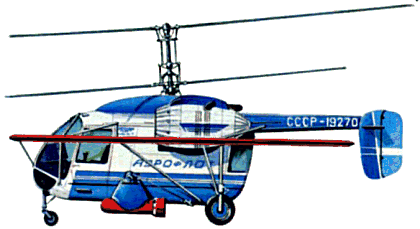
The Kamov Ka-26, which has the NATO codename Hoodlum, was announced in January 1964 as a light commercial helicopter with twin-turbine powerplant and a design making it easily convertible to meet the requirements of several roles. The primary task envisaged for the Ka-26, however, was agricultural.
The main need for such a helicopter was in remote areas, and so the Kamov design bureau opted for its standard co-axial contra-rotating twin rotor configuration, but powered by a pair of 325hp Vedeneev M-14V-26 radial piston engines because of the need for minimum fuel consumption. To leave the area under the transmission and rotor assemblies free for the payload, the engines were installed in pods at the ends of shoulder-mounted stub wings, the engines and transmission being connected by drive shafts with flexible couplings.
The first prototype flew in 1965, and state trials were successfully completed in the same year, allowing it to enter limited production during 1966.
The compact size and manoeuvrability of the Ka-26 proved a great asset for agricultural work, and the pod-and-boom design of the fuselage highly effective. The fuselage forward of the stub wings is a minimal pod with the crew cabin at the front, while the glassfibre tail unit is carried on twin booms and has conventional flying controls.
The design thus leaves the area under the engines and on the centre of gravity free for the payload. For agricultural work a 900kg hopper can be fitted, the load being spread by spray-bars or dust-spreaders under the hopper and aft of the tail assembly. For passenger operations the Ka-26 can be fitted with a detachable pod for six passengers on tip-up seats, and for freight work this pod can be used to carry up to 700kg.
The Ka-26 is thus a valuable general-purpose helicopter, despite the 'obsolescent' feature of piston engines. The greater weight of these units compared with turbines has been compensated by the use of lightweight materials in the airframe. Each of the interchangeable rotor blades, for example, is made of plastic, and weighs only 25kg; and much of the fuselage is made of aluminium panels sandwiched in glassfibre. Apart from saving weight, such features also reduce the problem of metal corrosion from the chemicals carried in the agricultural role.
--Bill Gunston "The Illustrated Encyclopedia of Commercial Aircraft", 1980
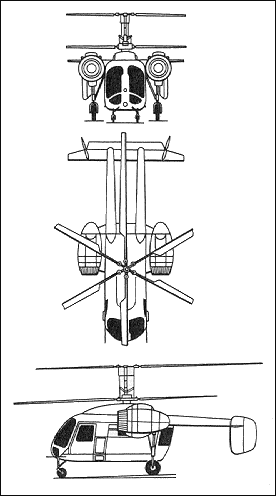
The first indication that his bureau was working on the design of a new, twin-engined general-purpose utility helicopter was given by Nikolai Kamov himself in January 1964. The prototype of this aircraft, the Ka-26, was flown for the first time in 1965, followed by a small pre-series batch and the first production Ka-26's during 1966. In its general appearance the Ka-26 shows a marked similarity to the Kaman H-43 Huskie, except that it retains the typical Kamov-type 3-blade co-axial rotor arrangement, whereas the American machine has separate rotor heads and intermeshing blades. The rotor blades, and parts of the fuselage of the Soviet aircraft, are of plastic and glassfibre construction.
The basic Ka-26 airframe comprises the 2-man crew cabin, rotor head and stub wings, with the engine pods at their extremities and twin tailbooms to the rear supporting the tail assembly. The tail unit is akin to that of a fixed-wing aeroplane, consisting of a tailplane and elevators and fins and rudders with a pronounced toe-in angle. The engines of those Ka-26's so far seen are Vedeneev radials, and not the Isotov shaft turbines that had been anticipated by western observers, but it is possible that later production aircraft could be turbine-powered. This would make the Ka-26 an even better proposition for a Ka-15 replacement, for the piston-engined Ka-26 has three times the load-carrying ability of the earlier type.
Considerable versatility of role is made possible in the Ka-26 by the use of interchangeable kits or units in the space behind the crew cabin and beneath the rotor head. These may take the form of a freight platform for a 900kg load; a winch for externally-slung crane loads; dust hoppers or liquid chemical tanks for agricultural use; a 'people pod' with a bench seat for 3 passengers along each side; or a similar cabin pod to accommodate a stretchers, 2 sitting patients and a medical attendant. Other likely applications of the Ka-26 include Arctic search and rescue, and ice, fishery or forestry patrols, either from land bases or ships' platforms. The Ka-26 is normally equipped for single-pilot operation, but dual controls can be fitted if desired. Six Ka-26's were ordered by an operator in Southern England in April 1967, the first order ever placed by a British customer for an aircraft designed and built in the USSR.
--K.Munson "Helicopters And Other Rotorcraft Since 1907", 1968
The Ka-26, designed at the beginning of the sixties, is built for maximum simplicity and versatility as a "lifting system" consisting of the powerplant, contra-rotating rotor assembly, cabin, landing gear and twin endplate fin tail unit. Loads and containers of various kinds can be installed immediately behind the cabin, beneath the rotors: a pod for six passengers, an open platform, tanks for liquid or solid insecticides or other products, and spray bars for agricultural use. A variant for geophysical survey is equipped with an electromagnetic pulse generator in the cabin and a big hoop antenna outside. Thanks to its compactness and stability, the Ka-26 can operate from small platforms and has been fitted with floats and used for fish-spotting.
The Ka-26 went into service on a large scale in 1970 and has been exported for both civil and military use.
--G.Apostolo "The Illustrated Encyclopedia of Helicopters", 1984
Technical data for Ka-26
Crew: 2, passengers: 6, engine: 2 x M-14V-26 pistone engine, rated at 239kW, rotor diameter: 13.0m, fuselage length: 7.75m, height: 4.05m, width: 3.64m, take-off weight: 3250kg, max speed: 160km/h, cruising speed: 130km/h, service ceiling: 3000m, range: 465km, payload: 900kg
--------------------------------------------------------------------------------
Kamov Ka-26SS
1988
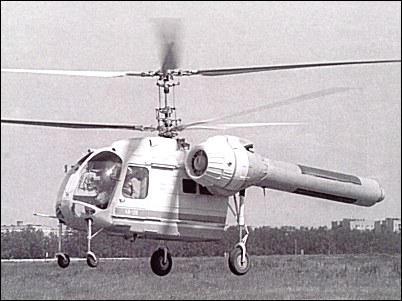
Ka-26SS, no-tail-rotor (NOTAR) technology testbed.
--G.Kuznetsov "OKB Kamov - 50 years", 1999
--------------------------------------------------------------------------------
Kamov Ka-126 "Hoodlum-B"
1988
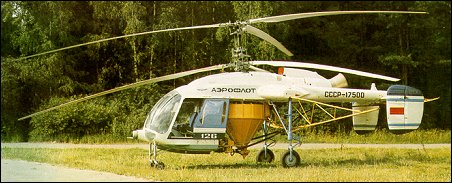
Ka-26 with engine pods removed from stub wings, fitted with one TVO-100 turboshaft engine positioned on top of fuselage, modified rotor blades, new fuel system. Prot. CCCP-01963 FF 19 Oct. 1988. Also built in Romania. Ka-128 had a 722shp Turbomeca Arriel 1D1 turboshaft.
--R.Simpson "Airlife's Helicopter and Rotorcraft", 1998
NATO reporting name: Hoodlum-B
TYPE: General purpose light turboshaft helicopter.
PROGRAMME: Development began 1984; early mockup had two small turboshafts above cabin; single turboshaft adopted subsequently; ground test vehicle completed early 1986; first flight of prototype (SSSR-01963) later 1986; first flight of first of four Soviet-built preproduction Ka-126s 19 October 1988. Proposed Ka-128, differing only in power plant and addition of an intermediate gearbox, has been abandoned.
DESIGN FEATURES: Compared with Ka-26 has turboshaft engine, significant increase in payload/endurance/range, and greater year-round utilisation; updated equipment includes new low-volume spraygear.
Contrarotating coaxial three-blade rotors; hinge rotor head with 'rake'-type blade attachment, to be succeeded eventually by hingeless head made of titanium and composites. Ka-26 blades of initial series to be succeeded by GFRP and CFRP blades with twin-contour spar, load-carrying rear section and electrothermal anti-icing; rotor brake standard; non-folding blades. Three-stage gearbox with planetary gear trains, of alloy steel and aluminium casting, flange mounted with four load-carrying bolts. Accessories include cooling fan, hydraulic pump and AC generator; engine input 6,000 rpm.
FLYING CONTROLS: Mechanical with irreversible hydraulic actuators. Automatic rotor constant-speed control; conventional four-channel control (longitudinal, lateral, cyclic and differential pitch). Two endplate fins and rudders, toed inward 15°; non-controllable horizontal stabiliser.
STRUCTURE: Airframe materials primarily aluminium alloys, steel alloys and composite sandwich panels of GFRP with honeycomb filler.
LANDING GEAR: Non-retractable four-wheel type. Main units, at rear, carried by stub-wings. All four units embody oleo-pneumatic shock-absorber. Forward wheels of castoring type, self-centring, no brakes. Rear wheels have pneumatic brakes. Mainwheel tyres size 595 x 185 mm, pressure 2.45 bars; forward wheel tyres size 300 x 125 mm, pressure 3.43 bars. Skis optional. Provision for large inflatable pontoons, across front of aircraft forward of front wheels and under each mainwheel.
POWER PLANT: One 522kW Mars (Omsk) TV-O-100 turboshaft, installed centrally in streamline fairing above cabin. Electronic-hydraulic automatic two-channel control system, with manual control in case of electronic governor failure. Front driveshaft with plate coupling to gearbox. Fuel in two forward and one aft tank, total capacity 800 litres. Provision for two external tanks, on sides of fuselage, total capacity 320 litres. Single-point main tank refuelling, on port side of aft tank.
ACCOMMODATION: Fully enclosed cabin, with rearward-sliding door each side; normal operation by single pilot; second seat and dual controls optional. Cabin ventilated, and warmed and demisted by air from combustion heater, which also heats passenger cabin when fitted. Air filter on nose of agricultural version. Space aft of cabin, between main landing gear legs and under transmission, can accommodate variety of interchangeable payloads. Cargo/passenger pod accommodates four or six persons on folding sidewall seats, with provision for seventh passenger beside pilot; two clamshell doors at rear of pod, emergency exit each side and hatch in floor. Ambulance pod accommodates two stretcher patients, two seated casualties and medical attendant. For agricultural work, chemical hopper (capacity 1,000 litres) and dust spreader or spraybars are fitted in this position, on aircraft's CG. Aircraft can also be operated with either an open platform for hauling freight or hook for slinging loads at end of a cable or in a cargo net.
SYSTEMS: Single hydraulic system, with manual override, for control actuators. Main electrical system 27V 3kW DC, with back-up 40Ah battery; secondary system 36/115V AC with two static inverters; 115/200V AC system with 16kVA generator (6kVA to power agricultural equipment and rotor anti-icing). Electrothermal rotor blade de-icing; hot air engine air intake anti-icing; alcohol windscreen anti-icing; electrically heated pitot. Pneumatic system for mainwheel brakes, tyre inflation, agricultural equipment control, pressure 39 to 49 bars. Oxygen system optional.
AVIONICS: Comms: VHF and HF radio; intercom; ADF; emergency locator beacon.
Instrumentation: Radar altimeter; main and back-up artificial horizons.
--Jane's Helicopter Markets and Systems
--------------------------------------------------------------------------------
Photo Gallery
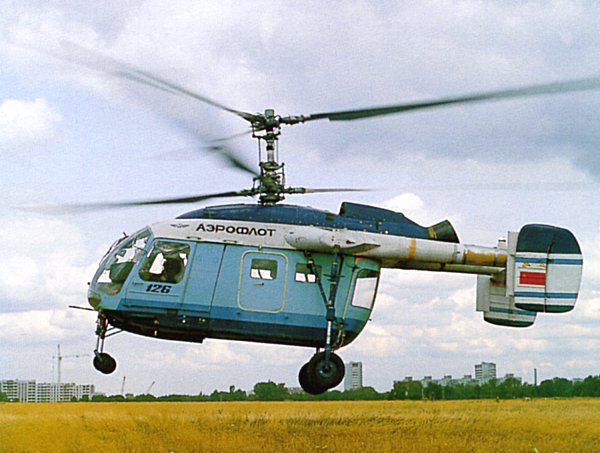
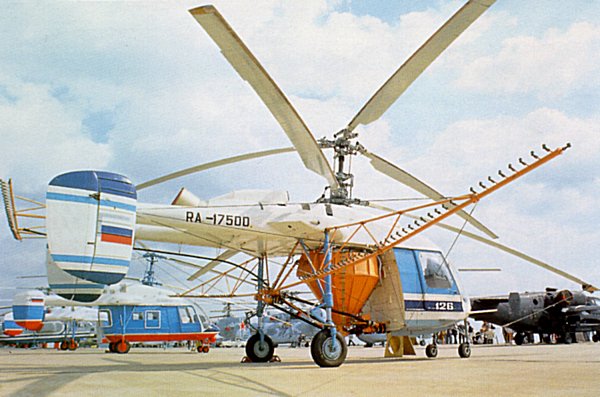
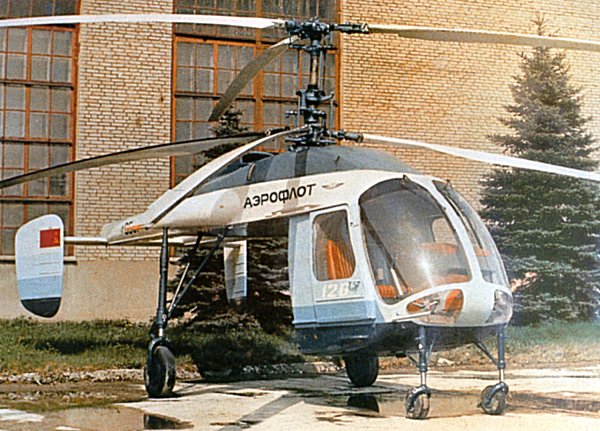
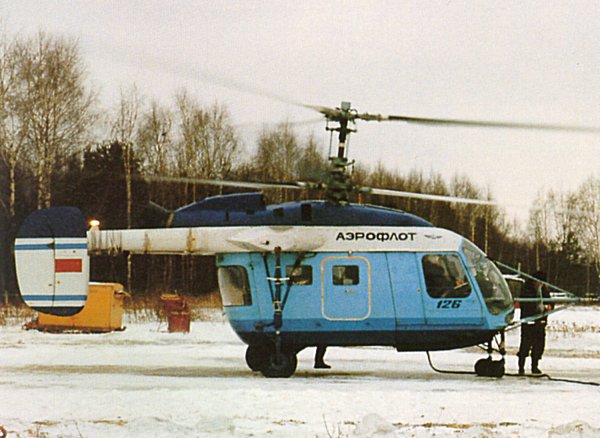
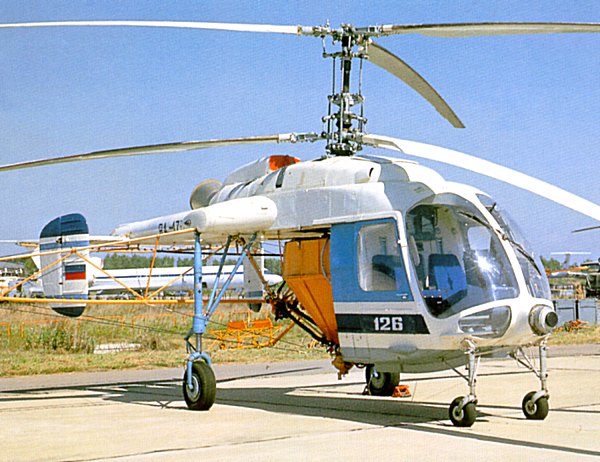
--------------------------------------------------------------------------------
Technical data for Ka-126
Engine: 1 x Omsk TVO-100 turboshaft, rated at 530kW, rotor diameter: 13.0m, fuselage length: 7.75m, height: 4.15m, take-off weight: 3000kg, max speed: 190km/h, cruising speed: 170km/h, rate of climb: 8.0m/s, service ceiling: 4650m, range: 660km, endurance: 5.3h, payload: 1000kg
--------------------------------------------------------------------------------
Kamov Ka-226
1997
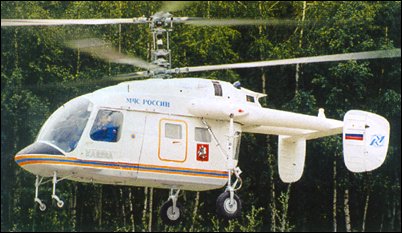
www.aviastar.org/helicopters_eng/ka-226.php
Ka-126 with two 420shp Allison 250-C20B turboshafts, deeper and wider two-seat cockpit with large windshield and nose, reshaped tail fins, modified transmission, enlarged cabin section with larger windows. Prot. FF 4 Sep. 1997.
--R.Simpson "Airlife's Helicopter and Rotorcraft", 1998
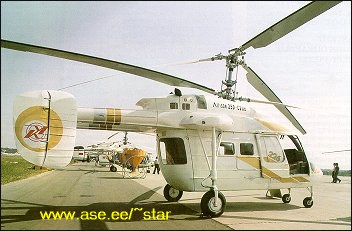
TYPE: Light utility helicopter.
PROGRAMME: Turbine version of Ka-26, of which 816 built between 1968 and 1977. Announced at 1990 Helicopter Association International convention, Dallas, USA. Developed originally for Russian TsENTROSPAS disaster relief ministry, which is providing significant funding. First flight (RA-00199), at Lyubertsy, 3 September 1997; "official" first flight on following day. Flew total of four sorties by 31 December 1997. Began AP-29 certification testing on 28 March 2001. State ground testing of Ka-226 second prototype completed at Strela's Orenburg plant on 6 March 2000. KAPP built two prototypes, of which first was rolled out at Kumertau on 29 May 1998; first production aircraft from KAPP was due to have flown in first quarter of 2002 but remained under construction in mid-2002. Planned certification in third quarter of 2002 was not achieved, being reportedly "seriously delayed". Prototype destroyed in ground resonance incident, November 2002.
Named Sergei in 1999, honouring politician Sergei Shoigu, but programme also guided by Sukhoi General Designer, Sergei Mikheev. By mid-2000, Moscow regional government had provided Rb 12 million in development funding and was beginning disbursements under second programme valued at Rb4 million. Initial deliveries due in first half of 2000, but not effected. Prototypes built jointly by Kamov, Strela, KAPP and Ufa Motors, with final assembly by KAPP and Strela for production aircraft. Strela scheduled to have delivered five preproduction helicopters to Kamov at Lyubertsy by mid-2000; these for MChS Rossii but not supplied until 2003, when one exhibited at MAKS '03. KAPP designated second production plant; first batch of five under construction by 2001. Motor-Sich of Zaporozhye, Ukraine, negotiated with Kamov in June 2000 to build Ka-226s powered by indigenous ZMKB AI-450 engine; agreement on AI-450 installation signed 15 August 2001. On 19 October 2001, however, Motor Sich announced it would source all Ka-226 components with Ukrainian industry, if decision to proceed were taken. Programme launch was reportedly imminent in late 2002. MoU on use of Turbomeca Arrius 2G signed in August 2001 with NPO Saturn and French manufacturer; collaboration agreement followed on 16 April 2002, with intention of certifying Arrius Ka-226 in September 2004 after trials of three prototypes. Batch of Rolls-Royce engines ordered by Kamov in July 2000.
CURRENT VERSIONS:
Ka-226A: As described.
Ka-226-50: Designation first revealed in September as "improved" version.
CUSTOMERS: Orders by January 2002 totalled 66: Gazprom 50, Moscow City 10, TsENTROSPAS five and Bashkiriya one.
Identified requirements include up to 20 for City of Moscow for patrol and medevac; some 250 for MChS Rossii/TsENTROSPAS disaster relief organisation; and up to 75 for Gazprom in gasfield support role. Firm order for 25 reportedly received from TsENTROSPAS by 1997, but quantity had reduced to 10 by 1999; by mid-2000 this quoted as five firm (to be first five production aircraft) and further 15 to be ordered by 2002; manufacture by Strela which had completed first two (including one in medevac configuration) by early 2002. Bashkiriyan local government ordered one Ka-226-50 in September 2001; this accepted 28 December 2001 (when still not cleared for flight) and due for trials at Zhukovsky before service entry. Funds for 22 of initial Gazprom order for 50 had been transferred by 2001, this initial batch, built by Strela, to have been received by 2005 (although formal signing of order for 50 was undertaken at Moscow Salon in August 2001).
Moscow city government signed US$1.5 million order for 10 in December 2001, delivery over two years, but later announcement indicated that funds had not been earmarked; Moscow's helicopters to be built by KAPP. City allocated initial Rb33 million in 2002 and intends to receive three helicopters in 2003, four in 2004 and final three in 2005. Ka-226 was beaten by Kazan Ansat in competition to supply new training helicopter to Russian armed forces, announced September 2001, although small number of Ka-226s required by Russian Navy.
COSTS: US$1.5 million (2000). Development cost Rb108 million (1999).
DESIGN FEATURES: Classic Kamov utility helicopter, featuring interchangeable mission pods. Refined development of Ka-26/126; new rotor system with hingeless hubs and glass fibre/carbon fibre blades; changes to shape of nose, twin tailfins and rudders, and passenger pod; passenger cabin has much larger windows and remains interchangeable with variety of payload modules including agricultural systems with hopper capacity of 1,000 litres; Kamov BP-226 transmission; new rotor system, interchangeable with standard coaxial system, will become available later.
FLYING CONTROLS: Assisted by irreversible hydraulic actuators. Automatic rotor constant-speed control; conventional four-channel control (longitudinal, lateral, cyclic and differential pitch). Two endplate fins and rudders, toed inward 15°; fixed horizontal stabiliser.
STRUCTURE: Primarily of aluminium alloys, steel alloys and composites sandwich panels of GFRP with honeycomb filler. Rotor blade overhaul interval 2,000 hours; total life 6,000 hours, but to be extended by increments to 18,000 hours.
LANDING GEAR: Non-retractable four-wheel type. Main units at rear, carried by stub-wings. All units embody oleo- pneumatic shock-absorber. Mainwheel tyres size 595x185, pressure 2.50 bar + 0.50; forward tyres size 300x125, pressure 3.50 bar + 0.50. Forward units of castoring type, without brakes. Rear wheels have pneumatic brakes.
POWER PLANT: Two 335kW Rolls-Royce 250- C20R/2 turboshafts, side by side aft of rotor mast, with individual driveshafts to rotor gearbox. Two 335kW Rolls-Royce 250-C20B engines in prototypes. Transmission rating 626kW. Alternatively, two Progress (ZMKB) AI-450 turboshafts, each 331kW or two Turbomeca Arrius 2G (500 kW) or Klimov VK-800 turboshafts (588kW). Standard fuel capacity 770 litres, in tanks above and forward of payload module area. Provision for two external tanks, on sides of fuselage, total capacity 320 litres.
ACCOMMODATION: Fully enclosed and lightly pressurised flight deck, with rearward-sliding door each side; normal operation by single pilot; second seat and dual controls optional. Cabin ventilated, and warmed and demisted by air from combustion heater, which also heats passenger cabin when fitted. Space aft of cabin, between main landing gear legs and under transmission, can accommodate variety of interchangeable payloads. Cargo/ passenger pod has two bench seats, each accommodating three persons; one bench faces forward, the other, rear; baggage compartment behind rear wall. Seventh passenger beside pilot on flight deck. Provision for cargo sling. Ambulance pod accommodates two stretcher patients, two seated casualties and medical attendant. For agricultural work, chemical hopper (capacity 1,000 litres) and dust spreader or spraybar are fitted in this position, on aircraft's CG. (Flight deck pressurisation protects crew against chemical ingress.) Aircraft can also be operated with either an open platform for hauling freight or hook for slinging loads at end of a cable or in a cargo net.
SYSTEMS: Single hydraulic system, with manual override, for control actuators. Main electrical system 27V 3kW DC, with back-up 40Ah battery; secondary system 36/115V AC with two static inverters; 115/200V AC system with 16kVA generator (6kVA to power agricultural equipment and rotor anti-icing). Electrothermal rotor blade de-icing; hot air engine air intake anti-icing; alcohol windscreen anti-icing; electrically heated pitot. Pneumatic system for mainwheel brakes, tyre inflation, agricultural equipment, control, pressure 39 to 49 bar. Oxygen system optional.
AVIONICS: Cockpit instrumentation and avionics - to customer's choice, including Bendix/King equipment for IFR flight.
Comms: Optional Bendix/King KY S96A VHF radio; transponder.
Flight: Optional Bendix/King KN 53 ILS; KR 87 ADF; KLN 90B GPS; LCR 92 laser AHRS; and ADF.
EQUIPMENT: Specially equipped payload modules available for variety of roles, including ambulance and agricultural duties. ARMAMENT: Optional provision for light weapons.
--Jane's All the World's Aircraft, 2004-2005
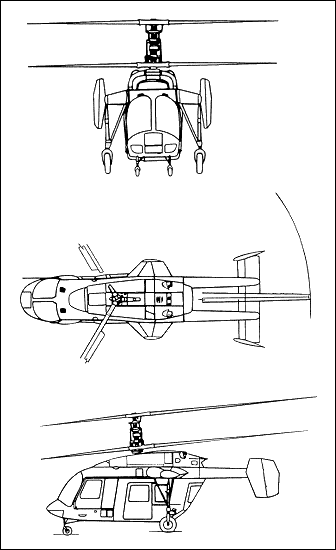
Ka-226 is intended for carrying passengers and cargo, and performs a wide range of tasks in the interests of various ministries and operators. The helicopter is equipped with up-to-date on-board equipment package and complies with the national aviation standards, as well as FAR requirements, categories A and B..
Ka-226 helicopter has coaxial rotor scheme with two three-blade rotors of 13-m diameter. The polymeric composite blade with advanced aerodynamic profile is semi-rigidly attached to the hub by a torsion bar. The helicopter features modular design (detachable transport-passenger cabin) and four-leg non-retractable landing gear. The coaxial rotor scheme makes Ka-226 helicopter highly maneuverable and eliminates the drawbacks resulted from the tail rotor of a single-rotor helicopters when maneuvering in the vicinity of various obstacles, and in particular, in turbulent atmosphere.
Ka-226 is a derivative of a well-known Ka-26 helicopter which fleet has flown nearly 3 million hours. The helicopter inherited the best qualities of its predecessor: simplicity of piloting techniques, low vibration level, reliability, flight safety and unpretentiousness in operation. The upgrading of the helicopter included replacement of piston engines to gas turbine engines, installation of new, aerodynamically more perfect, rotors, arrangement of new on-board avionics package and provision for comfortable conditions for the pilot and passengers. The design and manufacturing technology of Ka-226 satisfies modern production technologies ensuring long service life.
Modular design of the helicopter makes it possible to quickly develop new application versions of Ka-226. The basic version main roles are transportation of passengers and cargoes. Medical and police versions are also available. For the Ministry of Emergency situations an emergency-rescue version of Ka-226 is developed. At customer's options the export version of Ka-226 is equipped with western avionics.
-- www.airshow.ru
Technical data for Ka-226
Engine: 2 x Allison250-C20B turboshaft, rated at 308kW, rotor diameter: 13.0m, fuselage length: 8.1m, height: 4.15m, take-off weight: 3100kg, max speed: 205km/h, cruising speed: 192km/h, rate of climb: 11.7m/s, range: 600km, endurance: 4.6h, payload: 1300kg
1965
--------------------------------------------------------------------------------

www.aviastar.org/helicopters_eng/ka-26.php
NATO reporting name: Hoodlum-A
TYPE: Light twin-engined multipurpose helicopter.
PROGRAMME: Prototype first flew 1965; production aircraft entered agricultural service in Soviet Union 1970; 850 built. It is widely used on air ambulance services and is suitable for many other applications, including cargo and passenger transport, forest firefighting, mineral prospecting, pipeline construction, laying transmission lines and a number of military duties, including search and rescue.
The space aft of the cabin, between the main landing gear units and under the rotor transmission, is able to accommodate a variety of interchangeable payloads. For agricultural work the chemical hopper (capacity 900kg) and dust spreader or spraybars are fitted in this position, on the aircraft's centre of gravity. This equipment is quickly removable and can be replaced by a cargo/passenger pod accommodating four or six persons, with provision for a seventh passenger beside the pilot. Alternatively, the Ka-26 can be operated with either an open platform for hauling freight or a hook for slinging bulky loads at the end of a cable or in a cargo net.
A version for geophysical survey has an electromagnetic pulse generator in the cabin and is encircled by a huge 'hoop' antenna. It carries a mounting on the port side of the fuselage for the receiver 'bird' which is towed at the end of a cable, beneath the helicopter, when in use. The receiver is lowered by an electric winch and the cable is cut by automatic shears if its traction should exceed the authorised limit.
As an air ambulance, the Ka-26 can carry two stretcher patients, two seated casualties and a medical attendant. A winch, with a capacity of up to 150kg, enables it to be used for search and rescue duties. Ka-26s used in this role in Russian coastal areas are each fitted with three large inflatable pontoons, to permit operation from water. Items of equipment carried inside the cabin can include lifejackets and MLAS-1 inflatable dinghies for individual rescues, LAC-5 dinghies each able to carry five persons, PSN-1 rafts and emergency radio beacons. During tests, the hoist has been used to tow boats in Sea State 5 conditions.
When operating as an agricultural sprayer, the Ka-26 originally discharged its chemical payload at 1.5-12 litres/s. The rate of discharge in a dusting role was 1.5-12kg/s. Up to 120 ha could be sprayed during each flying hour at the rate of 50kg/ha. As a duster, 140 ha could be treated at the same discharge rate. 50 ha could be top-dressed with chemical fertilisers each hour, at a rate of 100kg/ha. These work rates were improved substantially by the introduction of an atomiser for liquid chemicals in 1978, followed by a centrifugal spreader for granular chemicals and dust in 1979.
To protect the pilot against toxic chemicals in the agricultural role, the cabin is lightly pressurised by a blower and air filter system which ensures that the cabin air is always clean. The flying and navigation equipment is adequate for all-weather operation, by day and night. VHF and HF radio are fitted, together with a radio compass and radio altimeter.
Because of its small size and manoeuvrability, the Ka-26 can be operated from platforms on small ships such as whalers and icebreakers, and a Soviet fishing boat operating in the North Atlantic in early 1970 carried a Ka-26 for fish spotting duties. This aircraft was equipped with inflated pontoons to permit alighting on the water.
In mid-1969, a Ka-26 was tested in Siberia and northwest USSR as a forest protection version able to deliver six firemen and their equipment speedily to the site of a forest fire. In the spring of 1972, Ka-26s joined Mi-1, Mi-2 and Mi-4 helicopters in operations to clear ice from Soviet rivers, by landing demolition teams on thick ice floes and destroying thinner ice fields from the air.
CUSTOMERS: Delivered for civilian use in 15 countries; military operators include the Hungarian Air Force.
DESIGN FEATURES: Airframe comprises backbone structure carrying flight deck, coaxial contrarotating rotors, landing gear, engine pods and twin tailbooms; space aft of flight deck, between main landing gear units and under rotor transmission, can accommodate interchangeable modules for passenger/freight transport, air ambulance, aerial survey, forest firefighting, mineral prospecting, pipeline and power transmission line construction, search and rescue, and (of primary importance) agricultural equipment.
POWER PLANT: Two 242.5kW Vedeneyev M-14V-26 air-cooled radial piston engines, mounted in pods on short stub wings at top of fuselage.
ACCOMMODATION: Fully enclosed cabin, with door on each side, fitted out normally for operation by single pilot; second seat and dual controls optional. Cabin warmed and demisted by air from combustion heater, which also heats passenger compartment when fitted. Air filter on nose of agricultural version. For agricultural work, a chemical hopper (capacity 900kg) and dust spreader or spraybars are fitted in module space, on the aircraft's centre of gravity. This equipment is quickly removable and can be replaced by a cargo/passenger pod accommodating four or six persons, with provision for a seventh passenger beside the pilot; or two stretcher patients, two seated casualties and a medical attendant in ambulance role. Alternatively, the Ka-26 can be operated with either an open platform for hauling freight or a hook for slinging bulky loads at the end of a cable or in a cargo net.
--Jane's Helicopter Markets and Systems

The year of 1956 saw the beginning of the wide-scale application of helicopters in the Soviet national economy. The need arose for helicopters capable of spreading fertilizers in the fields, orchards and vineyards and of combatting pests and weeds. To this end Ka-15M and Mi-1 helicopters were fitted with agricultural equipment. Operational experience gained with these types revealed the need for a dedicated helicopter with a bigger cargo-lifting capacity for performing a wide range of agricultural duties. This requirement was met by the Ka-26 featuring a modular design with interchangeable mission equipment (the "flying chassis").
In January 1964 the Soviet government issued a directive on the creation of the multi-purpose Ka-26 in two versions: the agricultural version capable of carrying 600-700kg of chemicals and the transport version for carrying passengers over distances of up to 400km. At the time our Civil Aviation already operated the agricultural version of the Mi-2 multi-purpose helicopter. The Kamov OKB was faced with the task to build a more cost-effective aircraft and did so with success. The Ka-26 design effort was headed by deputy chief designer M.A.Kupfer; Yu.I.Petrukhin was the leading designer and V.S.Dordan the leading engineer in charge of the flight tests.
The first circuit flight of the Ka-26 took place on August 18, 1965; the prototype was flown by test pilot V.V.Gromov. The State trials were successfully completed in the autumn of 1967 and production was launched in the town of Kumertau at a factory which had been purpose-built in 1962. The leaders of the OKB and its specialists rendered invaluable assistance in the setting up and development of the new aircraft factory. Their efforts were not wasted - the Kumertau Aircraft Production Association is currently continuing production of helicopters bearing the Kamov emblem, albeit helicopters of a new generation.
Between 1967 and 1970 several modifications of the Ka-26 were designed and tested: a shipboard version, an air ambulance version, a geological survey verson, a "flying crane", a highway patrol version etc. In its basic configuration the helicopter can be fitted with quickly detachable equipment packages, such as: passenger (cargo) cabin, cargo platform, hopper and spraybars for crop-spraying etc, and thus can be converted into any of the required versions within 1.5-2 hours. Due to the Ka-26's unusual modular design the specific versions were not allocated designations of the generally adopted style (i.e., with suffix letters), although they were just as numerous as, for example, those of the Mi-2 helicopter in the same class.
In the Ka-26 helicopter the Kamov OKB made its first large-scale use of parts and subassemblies made from composite materials. These included rotor blades, engine cowlings, the hopper for chemicals etc. The main achievement, however, was the organization of mass production of glassfibre rotor blades which ensured stability of aerodynamic characteristics under varying climatic conditions. Composite rotor blades had 5000-hour service life; in contrast, the metal blades of contemporary helicopter rotors had service life of less than 600-800 hours. The design and production technology of the blades have been patented in five countries outside the former Soviet Union; this know-how formed the basis for the production of improved new-generation rotor blades.
Single-rotor helicopters with a tail rotor are in production in Russia, the USA, France, Germany, Great Britain, Italy and elsewhere. It is an open secret that the helicopter design bureaux of these countries make use of the achievements of their competitors. When designing co-axial helicopters, N.I.Kamov's OKB virtually does not have to borrow from foreign experience, because it is exactly the Kamov OKB that "dictates the fashions" in this field. The company's rotorcraft possess so-called "patent purity". It was not least this circumstance that enabled the Ka-26 as the only Soviet helicopter to be certificated in accordance with US FAR 29 airworthiness regulations. It was also the only Soviet helicopter to be sold abroad on a commercial basis; the Ka-26 was exported to 17 foreign countries. For more than 30 years it has been doing its job with dignity. The total flying hours amassed by the type amount to 2,907,000 hours. In 1980 and 1982 the Ka-26 established five world records.
--G.Kuznetsov "OKB Kamov - 50 years", 1999

The Kamov Ka-26, which has the NATO codename Hoodlum, was announced in January 1964 as a light commercial helicopter with twin-turbine powerplant and a design making it easily convertible to meet the requirements of several roles. The primary task envisaged for the Ka-26, however, was agricultural.
The main need for such a helicopter was in remote areas, and so the Kamov design bureau opted for its standard co-axial contra-rotating twin rotor configuration, but powered by a pair of 325hp Vedeneev M-14V-26 radial piston engines because of the need for minimum fuel consumption. To leave the area under the transmission and rotor assemblies free for the payload, the engines were installed in pods at the ends of shoulder-mounted stub wings, the engines and transmission being connected by drive shafts with flexible couplings.
The first prototype flew in 1965, and state trials were successfully completed in the same year, allowing it to enter limited production during 1966.
The compact size and manoeuvrability of the Ka-26 proved a great asset for agricultural work, and the pod-and-boom design of the fuselage highly effective. The fuselage forward of the stub wings is a minimal pod with the crew cabin at the front, while the glassfibre tail unit is carried on twin booms and has conventional flying controls.
The design thus leaves the area under the engines and on the centre of gravity free for the payload. For agricultural work a 900kg hopper can be fitted, the load being spread by spray-bars or dust-spreaders under the hopper and aft of the tail assembly. For passenger operations the Ka-26 can be fitted with a detachable pod for six passengers on tip-up seats, and for freight work this pod can be used to carry up to 700kg.
The Ka-26 is thus a valuable general-purpose helicopter, despite the 'obsolescent' feature of piston engines. The greater weight of these units compared with turbines has been compensated by the use of lightweight materials in the airframe. Each of the interchangeable rotor blades, for example, is made of plastic, and weighs only 25kg; and much of the fuselage is made of aluminium panels sandwiched in glassfibre. Apart from saving weight, such features also reduce the problem of metal corrosion from the chemicals carried in the agricultural role.
--Bill Gunston "The Illustrated Encyclopedia of Commercial Aircraft", 1980

The first indication that his bureau was working on the design of a new, twin-engined general-purpose utility helicopter was given by Nikolai Kamov himself in January 1964. The prototype of this aircraft, the Ka-26, was flown for the first time in 1965, followed by a small pre-series batch and the first production Ka-26's during 1966. In its general appearance the Ka-26 shows a marked similarity to the Kaman H-43 Huskie, except that it retains the typical Kamov-type 3-blade co-axial rotor arrangement, whereas the American machine has separate rotor heads and intermeshing blades. The rotor blades, and parts of the fuselage of the Soviet aircraft, are of plastic and glassfibre construction.
The basic Ka-26 airframe comprises the 2-man crew cabin, rotor head and stub wings, with the engine pods at their extremities and twin tailbooms to the rear supporting the tail assembly. The tail unit is akin to that of a fixed-wing aeroplane, consisting of a tailplane and elevators and fins and rudders with a pronounced toe-in angle. The engines of those Ka-26's so far seen are Vedeneev radials, and not the Isotov shaft turbines that had been anticipated by western observers, but it is possible that later production aircraft could be turbine-powered. This would make the Ka-26 an even better proposition for a Ka-15 replacement, for the piston-engined Ka-26 has three times the load-carrying ability of the earlier type.
Considerable versatility of role is made possible in the Ka-26 by the use of interchangeable kits or units in the space behind the crew cabin and beneath the rotor head. These may take the form of a freight platform for a 900kg load; a winch for externally-slung crane loads; dust hoppers or liquid chemical tanks for agricultural use; a 'people pod' with a bench seat for 3 passengers along each side; or a similar cabin pod to accommodate a stretchers, 2 sitting patients and a medical attendant. Other likely applications of the Ka-26 include Arctic search and rescue, and ice, fishery or forestry patrols, either from land bases or ships' platforms. The Ka-26 is normally equipped for single-pilot operation, but dual controls can be fitted if desired. Six Ka-26's were ordered by an operator in Southern England in April 1967, the first order ever placed by a British customer for an aircraft designed and built in the USSR.
--K.Munson "Helicopters And Other Rotorcraft Since 1907", 1968
The Ka-26, designed at the beginning of the sixties, is built for maximum simplicity and versatility as a "lifting system" consisting of the powerplant, contra-rotating rotor assembly, cabin, landing gear and twin endplate fin tail unit. Loads and containers of various kinds can be installed immediately behind the cabin, beneath the rotors: a pod for six passengers, an open platform, tanks for liquid or solid insecticides or other products, and spray bars for agricultural use. A variant for geophysical survey is equipped with an electromagnetic pulse generator in the cabin and a big hoop antenna outside. Thanks to its compactness and stability, the Ka-26 can operate from small platforms and has been fitted with floats and used for fish-spotting.
The Ka-26 went into service on a large scale in 1970 and has been exported for both civil and military use.
--G.Apostolo "The Illustrated Encyclopedia of Helicopters", 1984
Technical data for Ka-26
Crew: 2, passengers: 6, engine: 2 x M-14V-26 pistone engine, rated at 239kW, rotor diameter: 13.0m, fuselage length: 7.75m, height: 4.05m, width: 3.64m, take-off weight: 3250kg, max speed: 160km/h, cruising speed: 130km/h, service ceiling: 3000m, range: 465km, payload: 900kg
--------------------------------------------------------------------------------
Kamov Ka-26SS
1988

Ka-26SS, no-tail-rotor (NOTAR) technology testbed.
--G.Kuznetsov "OKB Kamov - 50 years", 1999
--------------------------------------------------------------------------------
Kamov Ka-126 "Hoodlum-B"
1988

Ka-26 with engine pods removed from stub wings, fitted with one TVO-100 turboshaft engine positioned on top of fuselage, modified rotor blades, new fuel system. Prot. CCCP-01963 FF 19 Oct. 1988. Also built in Romania. Ka-128 had a 722shp Turbomeca Arriel 1D1 turboshaft.
--R.Simpson "Airlife's Helicopter and Rotorcraft", 1998
NATO reporting name: Hoodlum-B
TYPE: General purpose light turboshaft helicopter.
PROGRAMME: Development began 1984; early mockup had two small turboshafts above cabin; single turboshaft adopted subsequently; ground test vehicle completed early 1986; first flight of prototype (SSSR-01963) later 1986; first flight of first of four Soviet-built preproduction Ka-126s 19 October 1988. Proposed Ka-128, differing only in power plant and addition of an intermediate gearbox, has been abandoned.
DESIGN FEATURES: Compared with Ka-26 has turboshaft engine, significant increase in payload/endurance/range, and greater year-round utilisation; updated equipment includes new low-volume spraygear.
Contrarotating coaxial three-blade rotors; hinge rotor head with 'rake'-type blade attachment, to be succeeded eventually by hingeless head made of titanium and composites. Ka-26 blades of initial series to be succeeded by GFRP and CFRP blades with twin-contour spar, load-carrying rear section and electrothermal anti-icing; rotor brake standard; non-folding blades. Three-stage gearbox with planetary gear trains, of alloy steel and aluminium casting, flange mounted with four load-carrying bolts. Accessories include cooling fan, hydraulic pump and AC generator; engine input 6,000 rpm.
FLYING CONTROLS: Mechanical with irreversible hydraulic actuators. Automatic rotor constant-speed control; conventional four-channel control (longitudinal, lateral, cyclic and differential pitch). Two endplate fins and rudders, toed inward 15°; non-controllable horizontal stabiliser.
STRUCTURE: Airframe materials primarily aluminium alloys, steel alloys and composite sandwich panels of GFRP with honeycomb filler.
LANDING GEAR: Non-retractable four-wheel type. Main units, at rear, carried by stub-wings. All four units embody oleo-pneumatic shock-absorber. Forward wheels of castoring type, self-centring, no brakes. Rear wheels have pneumatic brakes. Mainwheel tyres size 595 x 185 mm, pressure 2.45 bars; forward wheel tyres size 300 x 125 mm, pressure 3.43 bars. Skis optional. Provision for large inflatable pontoons, across front of aircraft forward of front wheels and under each mainwheel.
POWER PLANT: One 522kW Mars (Omsk) TV-O-100 turboshaft, installed centrally in streamline fairing above cabin. Electronic-hydraulic automatic two-channel control system, with manual control in case of electronic governor failure. Front driveshaft with plate coupling to gearbox. Fuel in two forward and one aft tank, total capacity 800 litres. Provision for two external tanks, on sides of fuselage, total capacity 320 litres. Single-point main tank refuelling, on port side of aft tank.
ACCOMMODATION: Fully enclosed cabin, with rearward-sliding door each side; normal operation by single pilot; second seat and dual controls optional. Cabin ventilated, and warmed and demisted by air from combustion heater, which also heats passenger cabin when fitted. Air filter on nose of agricultural version. Space aft of cabin, between main landing gear legs and under transmission, can accommodate variety of interchangeable payloads. Cargo/passenger pod accommodates four or six persons on folding sidewall seats, with provision for seventh passenger beside pilot; two clamshell doors at rear of pod, emergency exit each side and hatch in floor. Ambulance pod accommodates two stretcher patients, two seated casualties and medical attendant. For agricultural work, chemical hopper (capacity 1,000 litres) and dust spreader or spraybars are fitted in this position, on aircraft's CG. Aircraft can also be operated with either an open platform for hauling freight or hook for slinging loads at end of a cable or in a cargo net.
SYSTEMS: Single hydraulic system, with manual override, for control actuators. Main electrical system 27V 3kW DC, with back-up 40Ah battery; secondary system 36/115V AC with two static inverters; 115/200V AC system with 16kVA generator (6kVA to power agricultural equipment and rotor anti-icing). Electrothermal rotor blade de-icing; hot air engine air intake anti-icing; alcohol windscreen anti-icing; electrically heated pitot. Pneumatic system for mainwheel brakes, tyre inflation, agricultural equipment control, pressure 39 to 49 bars. Oxygen system optional.
AVIONICS: Comms: VHF and HF radio; intercom; ADF; emergency locator beacon.
Instrumentation: Radar altimeter; main and back-up artificial horizons.
--Jane's Helicopter Markets and Systems
--------------------------------------------------------------------------------
Photo Gallery





--------------------------------------------------------------------------------
Technical data for Ka-126
Engine: 1 x Omsk TVO-100 turboshaft, rated at 530kW, rotor diameter: 13.0m, fuselage length: 7.75m, height: 4.15m, take-off weight: 3000kg, max speed: 190km/h, cruising speed: 170km/h, rate of climb: 8.0m/s, service ceiling: 4650m, range: 660km, endurance: 5.3h, payload: 1000kg
--------------------------------------------------------------------------------
Kamov Ka-226
1997

www.aviastar.org/helicopters_eng/ka-226.php
Ka-126 with two 420shp Allison 250-C20B turboshafts, deeper and wider two-seat cockpit with large windshield and nose, reshaped tail fins, modified transmission, enlarged cabin section with larger windows. Prot. FF 4 Sep. 1997.
--R.Simpson "Airlife's Helicopter and Rotorcraft", 1998

TYPE: Light utility helicopter.
PROGRAMME: Turbine version of Ka-26, of which 816 built between 1968 and 1977. Announced at 1990 Helicopter Association International convention, Dallas, USA. Developed originally for Russian TsENTROSPAS disaster relief ministry, which is providing significant funding. First flight (RA-00199), at Lyubertsy, 3 September 1997; "official" first flight on following day. Flew total of four sorties by 31 December 1997. Began AP-29 certification testing on 28 March 2001. State ground testing of Ka-226 second prototype completed at Strela's Orenburg plant on 6 March 2000. KAPP built two prototypes, of which first was rolled out at Kumertau on 29 May 1998; first production aircraft from KAPP was due to have flown in first quarter of 2002 but remained under construction in mid-2002. Planned certification in third quarter of 2002 was not achieved, being reportedly "seriously delayed". Prototype destroyed in ground resonance incident, November 2002.
Named Sergei in 1999, honouring politician Sergei Shoigu, but programme also guided by Sukhoi General Designer, Sergei Mikheev. By mid-2000, Moscow regional government had provided Rb 12 million in development funding and was beginning disbursements under second programme valued at Rb4 million. Initial deliveries due in first half of 2000, but not effected. Prototypes built jointly by Kamov, Strela, KAPP and Ufa Motors, with final assembly by KAPP and Strela for production aircraft. Strela scheduled to have delivered five preproduction helicopters to Kamov at Lyubertsy by mid-2000; these for MChS Rossii but not supplied until 2003, when one exhibited at MAKS '03. KAPP designated second production plant; first batch of five under construction by 2001. Motor-Sich of Zaporozhye, Ukraine, negotiated with Kamov in June 2000 to build Ka-226s powered by indigenous ZMKB AI-450 engine; agreement on AI-450 installation signed 15 August 2001. On 19 October 2001, however, Motor Sich announced it would source all Ka-226 components with Ukrainian industry, if decision to proceed were taken. Programme launch was reportedly imminent in late 2002. MoU on use of Turbomeca Arrius 2G signed in August 2001 with NPO Saturn and French manufacturer; collaboration agreement followed on 16 April 2002, with intention of certifying Arrius Ka-226 in September 2004 after trials of three prototypes. Batch of Rolls-Royce engines ordered by Kamov in July 2000.
CURRENT VERSIONS:
Ka-226A: As described.
Ka-226-50: Designation first revealed in September as "improved" version.
CUSTOMERS: Orders by January 2002 totalled 66: Gazprom 50, Moscow City 10, TsENTROSPAS five and Bashkiriya one.
Identified requirements include up to 20 for City of Moscow for patrol and medevac; some 250 for MChS Rossii/TsENTROSPAS disaster relief organisation; and up to 75 for Gazprom in gasfield support role. Firm order for 25 reportedly received from TsENTROSPAS by 1997, but quantity had reduced to 10 by 1999; by mid-2000 this quoted as five firm (to be first five production aircraft) and further 15 to be ordered by 2002; manufacture by Strela which had completed first two (including one in medevac configuration) by early 2002. Bashkiriyan local government ordered one Ka-226-50 in September 2001; this accepted 28 December 2001 (when still not cleared for flight) and due for trials at Zhukovsky before service entry. Funds for 22 of initial Gazprom order for 50 had been transferred by 2001, this initial batch, built by Strela, to have been received by 2005 (although formal signing of order for 50 was undertaken at Moscow Salon in August 2001).
Moscow city government signed US$1.5 million order for 10 in December 2001, delivery over two years, but later announcement indicated that funds had not been earmarked; Moscow's helicopters to be built by KAPP. City allocated initial Rb33 million in 2002 and intends to receive three helicopters in 2003, four in 2004 and final three in 2005. Ka-226 was beaten by Kazan Ansat in competition to supply new training helicopter to Russian armed forces, announced September 2001, although small number of Ka-226s required by Russian Navy.
COSTS: US$1.5 million (2000). Development cost Rb108 million (1999).
DESIGN FEATURES: Classic Kamov utility helicopter, featuring interchangeable mission pods. Refined development of Ka-26/126; new rotor system with hingeless hubs and glass fibre/carbon fibre blades; changes to shape of nose, twin tailfins and rudders, and passenger pod; passenger cabin has much larger windows and remains interchangeable with variety of payload modules including agricultural systems with hopper capacity of 1,000 litres; Kamov BP-226 transmission; new rotor system, interchangeable with standard coaxial system, will become available later.
FLYING CONTROLS: Assisted by irreversible hydraulic actuators. Automatic rotor constant-speed control; conventional four-channel control (longitudinal, lateral, cyclic and differential pitch). Two endplate fins and rudders, toed inward 15°; fixed horizontal stabiliser.
STRUCTURE: Primarily of aluminium alloys, steel alloys and composites sandwich panels of GFRP with honeycomb filler. Rotor blade overhaul interval 2,000 hours; total life 6,000 hours, but to be extended by increments to 18,000 hours.
LANDING GEAR: Non-retractable four-wheel type. Main units at rear, carried by stub-wings. All units embody oleo- pneumatic shock-absorber. Mainwheel tyres size 595x185, pressure 2.50 bar + 0.50; forward tyres size 300x125, pressure 3.50 bar + 0.50. Forward units of castoring type, without brakes. Rear wheels have pneumatic brakes.
POWER PLANT: Two 335kW Rolls-Royce 250- C20R/2 turboshafts, side by side aft of rotor mast, with individual driveshafts to rotor gearbox. Two 335kW Rolls-Royce 250-C20B engines in prototypes. Transmission rating 626kW. Alternatively, two Progress (ZMKB) AI-450 turboshafts, each 331kW or two Turbomeca Arrius 2G (500 kW) or Klimov VK-800 turboshafts (588kW). Standard fuel capacity 770 litres, in tanks above and forward of payload module area. Provision for two external tanks, on sides of fuselage, total capacity 320 litres.
ACCOMMODATION: Fully enclosed and lightly pressurised flight deck, with rearward-sliding door each side; normal operation by single pilot; second seat and dual controls optional. Cabin ventilated, and warmed and demisted by air from combustion heater, which also heats passenger cabin when fitted. Space aft of cabin, between main landing gear legs and under transmission, can accommodate variety of interchangeable payloads. Cargo/ passenger pod has two bench seats, each accommodating three persons; one bench faces forward, the other, rear; baggage compartment behind rear wall. Seventh passenger beside pilot on flight deck. Provision for cargo sling. Ambulance pod accommodates two stretcher patients, two seated casualties and medical attendant. For agricultural work, chemical hopper (capacity 1,000 litres) and dust spreader or spraybar are fitted in this position, on aircraft's CG. (Flight deck pressurisation protects crew against chemical ingress.) Aircraft can also be operated with either an open platform for hauling freight or hook for slinging loads at end of a cable or in a cargo net.
SYSTEMS: Single hydraulic system, with manual override, for control actuators. Main electrical system 27V 3kW DC, with back-up 40Ah battery; secondary system 36/115V AC with two static inverters; 115/200V AC system with 16kVA generator (6kVA to power agricultural equipment and rotor anti-icing). Electrothermal rotor blade de-icing; hot air engine air intake anti-icing; alcohol windscreen anti-icing; electrically heated pitot. Pneumatic system for mainwheel brakes, tyre inflation, agricultural equipment, control, pressure 39 to 49 bar. Oxygen system optional.
AVIONICS: Cockpit instrumentation and avionics - to customer's choice, including Bendix/King equipment for IFR flight.
Comms: Optional Bendix/King KY S96A VHF radio; transponder.
Flight: Optional Bendix/King KN 53 ILS; KR 87 ADF; KLN 90B GPS; LCR 92 laser AHRS; and ADF.
EQUIPMENT: Specially equipped payload modules available for variety of roles, including ambulance and agricultural duties. ARMAMENT: Optional provision for light weapons.
--Jane's All the World's Aircraft, 2004-2005

Ka-226 is intended for carrying passengers and cargo, and performs a wide range of tasks in the interests of various ministries and operators. The helicopter is equipped with up-to-date on-board equipment package and complies with the national aviation standards, as well as FAR requirements, categories A and B..
Ka-226 helicopter has coaxial rotor scheme with two three-blade rotors of 13-m diameter. The polymeric composite blade with advanced aerodynamic profile is semi-rigidly attached to the hub by a torsion bar. The helicopter features modular design (detachable transport-passenger cabin) and four-leg non-retractable landing gear. The coaxial rotor scheme makes Ka-226 helicopter highly maneuverable and eliminates the drawbacks resulted from the tail rotor of a single-rotor helicopters when maneuvering in the vicinity of various obstacles, and in particular, in turbulent atmosphere.
Ka-226 is a derivative of a well-known Ka-26 helicopter which fleet has flown nearly 3 million hours. The helicopter inherited the best qualities of its predecessor: simplicity of piloting techniques, low vibration level, reliability, flight safety and unpretentiousness in operation. The upgrading of the helicopter included replacement of piston engines to gas turbine engines, installation of new, aerodynamically more perfect, rotors, arrangement of new on-board avionics package and provision for comfortable conditions for the pilot and passengers. The design and manufacturing technology of Ka-226 satisfies modern production technologies ensuring long service life.
Modular design of the helicopter makes it possible to quickly develop new application versions of Ka-226. The basic version main roles are transportation of passengers and cargoes. Medical and police versions are also available. For the Ministry of Emergency situations an emergency-rescue version of Ka-226 is developed. At customer's options the export version of Ka-226 is equipped with western avionics.
-- www.airshow.ru
Technical data for Ka-226
Engine: 2 x Allison250-C20B turboshaft, rated at 308kW, rotor diameter: 13.0m, fuselage length: 8.1m, height: 4.15m, take-off weight: 3100kg, max speed: 205km/h, cruising speed: 192km/h, rate of climb: 11.7m/s, range: 600km, endurance: 4.6h, payload: 1300kg





